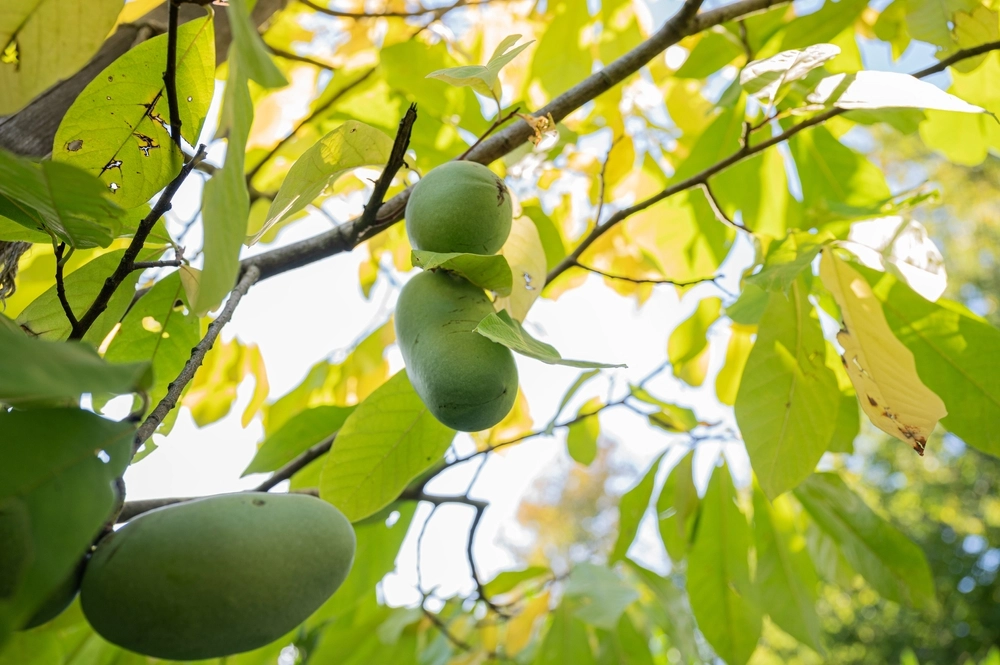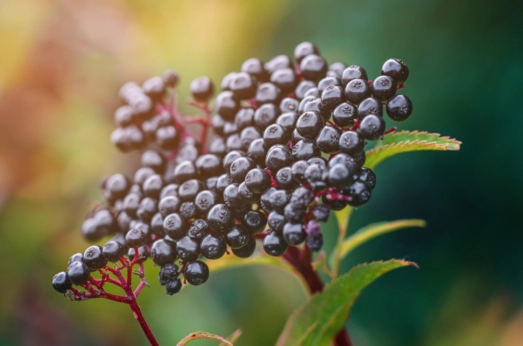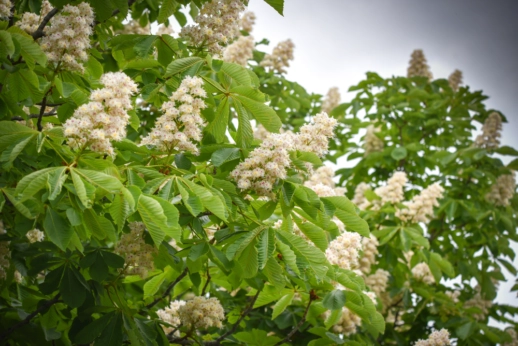Your Questions About Agroforestry, Answered
We asked Modern Farmer readers what they wanted to know about planting trees.
Your Questions About Agroforestry, Answered
We asked Modern Farmer readers what they wanted to know about planting trees.

Pawpaws are the largest edible fruit indigenous to the US.by Shutterstock.
Agroforestry is on the mind for Modern Farmer readers, who chimed in to ask for more coverage of how trees and shrubs can integrate into agricultural landscapes this year. As part of our recent agroforestry coverage, we profiled some Midwestern farmers using their land to reestablish the connection between trees and food production and highlighted the work of the Savanna Institute, a nonprofit that works towards agroforestry adoption in the Midwest.
We also asked readers what questions they had for agroforesty experts. Here’s what you wanted to know, with answers provided by Savanna Institute executive director Keefe Keeley:
Q: How can I incorporate agroforestry practices into my small home garden?
A: Agroforestry practices help us think about how woody, perennial shrub plants can be incorporated into farming systems, as well as how food production can be achieved in forested environments. This can help you with your gardening as well. If your yard or garden is heavily shaded, you may be able to grow plants or mushrooms used in forest farming, which takes place under a closed canopy. If you are limited by space, you could consider growing perennial woody shrubs such as elderberries or black currants, which can begin producing berries in 2-3 years. Agroforestry invites us to think about how systems connect. Your plants could help provide a windbreak or visual barrier, habitat for wildlife and pollinators and food for your table all at the same time.
Q: If you want to plant an orchard with a guild but are limited on resources, which plants should be prioritized?
A: While plant selection will vary based on your specific location and goals, some agroforestry species have notable intercropping potential. Black currants and pawpaws are two examples of shade-tolerant species that can grow well with other types of trees. You can see examples of groupings used by other farms on our website and YouTube channel.
Q: How do you keep deer from eating the trees and shrubs (aside from building a giant cage fence around each one)? We would like to reforest a section of our property, but can’t imagine caging that many trees.
A: We are experimenting with a few different deer-deterrent strategies at our demonstration farms. We have had success with using five-foot high tree tubes for each tree (which offers other benefits as well) and with 3D deer fence: two separate electrified fences set three to four feet apart. This creates “depth” and makes it difficult for the deer to jump over them.

Q: What equipment do you use to dig holes to plant trees? A spade and rocky ground is hard-going.
A: We use a variety of equipment for planting woody shrubs. Depending on what is being planted and the soil quality, this could include a trencher and tree planter pulled behind a tractor, a PTO-driven post hole digger or some of the modified precision ag equipment we are experimenting with on our demonstration farms. You can learn more and see examples on our YouTube channel.
Q: Any sources for chestnuts? Seems that most nurseries in Canada are always sold out.
A: One of the biggest challenges to expanding agroforestry is the shortage of plant material currently available for purchase and planting. That’s why we launched a nursery with our partners Canopy Farm Management, which offers tree planting and plant material in the region. As members of the Agroforestry Coalition, we also work with others across the country to improve nursery stock availability and production.
Q: I know chestnuts prefer well-drained soils. How can those of us on more poorly drained soil grow the highest-value tree crop? Is there any research about using swales or planting in fields with drainage tiles?
A: “We are working with Canopy Farm Management to develop a series of mapping tools to help people identify areas of their land that would be most suitable—or unsuitable—for different agroforestry crops. These will be available later this year. Drainage tiles (which are common in Midwest farm fields) are a concern for many growers. We do not have much research or experience growing chestnuts with drainage tiles, but we’re working to learn more.”
Q: What are three of the fastest-growing trees for an emerging Southern California food forest?
A: Since most of our work is focused on the US Midwest, I would refer you to some of our collaborators in the southwest region. This video by the Quivira Coalition featuring Roxanne Swentzell could offer some insights.
Q: Is there a comparable program [to SI] to help new farmers enter into agroforestry, including forest farming, in [a] mountain area of Maryland?
A: We are partnering on a new Expanding Agroforestry Project with Virginia Tech, which is working in Maryland. You should also check out Appalachian Sustainable Development, which is working to support agroforestry and forest farming in your region.

In addition to reader questions, Keeley offered answers to three of the questions the Savanna Institute hears most frequently:
Q: Where can I find plants?
A: Talking with your local conservation specialists is often the best way to find plant sources that are a good fit for your location. The nation-wide Agroforestry Coalition has identified nursery stock and plant availability as a key bottleneck in expanding agroforestry production, so certain crops and varieties can be hard to find. We work closely with Canopy Farm Management, which offers agroforestry crops suited for the Midwest. For more nurseries in your area, check out the National Nursery and Seed Directory.
Q: Where/how can I sell my products?
A: In any farm enterprise, it’s important to identify market opportunities in advance and design your operation with these in mind. Farms using agroforestry sell products through the market channels all farms use—they just have more trees at work benefiting the crops and livestock on their farms. On some farms, the trees provide the primary crops: fruits, nuts, timber and other tree products. These farms sell their products through U-pick businesses, direct-to-consumer sales and regional wholesale distributors. Many tree crops are best sold as value-added products, which entails additional processing costs but can open up additional marketing opportunities.
Q: How do I find land to do agroforestry?
A: If you are thinking about planting tree crops, you will need long-term access to land to reap the full benefits of your investment. This is a significant obstacle for most beginning agroforestry farmers. Developing a detailed business plan and building relationships in your local community are important steps towards achieving this goal. Our new interactive guide, Designing An Effective Long-Term Agroforestry Lease, helps you work through key considerations for acquiring long-term access to land.
Do you have more questions for the Savanna Institute? Check out its “Ask an Agroforester” page for more frequently asked questions and to submit your own.
Follow us
This work is licensed under a Creative Commons Attribution-NoDerivatives 4.0 International License.
Want to republish a Modern Farmer story?
We are happy for Modern Farmer stories to be shared, and encourage you to republish our articles for your audience. When doing so, we ask that you follow these guidelines:
Please credit us and our writers
For the author byline, please use “Author Name, Modern Farmer.” At the top of our stories, if on the web, please include this text and link: “This story was originally published by Modern Farmer.”
Please make sure to include a link back to either our home page or the article URL.
At the bottom of the story, please include the following text:
“Modern Farmer is a nonprofit initiative dedicated to raising awareness and catalyzing action at the intersection of food, agriculture, and society. Read more at <link>Modern Farmer</link>.”
Use our widget
We’d like to be able to track our stories, so we ask that if you republish our content, you do so using our widget (located on the left hand side of the article). The HTML code has a built-in tracker that tells us the data and domain where the story was published, as well as view counts.
Check the image requirements
It’s your responsibility to confirm you're licensed to republish images in our articles. Some images, such as those from commercial providers, don't allow their images to be republished without permission or payment. Copyright terms are generally listed in the image caption and attribution. You are welcome to omit our images or substitute with your own. Charts and interactive graphics follow the same rules.
Don’t change too much. Or, ask us first.
Articles must be republished in their entirety. It’s okay to change references to time (“today” to “yesterday”) or location (“Iowa City, IA” to “here”). But please keep everything else the same.
If you feel strongly that a more material edit needs to be made, get in touch with us at [email protected]. We’re happy to discuss it with the original author, but we must have prior approval for changes before publication.
Special cases
Extracts. You may run the first few lines or paragraphs of the article and then say: “Read the full article at Modern Farmer” with a link back to the original article.
Quotes. You may quote authors provided you include a link back to the article URL.
Translations. These require writer approval. To inquire about translation of a Modern Farmer article, contact us at [email protected]
Signed consent / copyright release forms. These are not required, provided you are following these guidelines.
Print. Articles can be republished in print under these same rules, with the exception that you do not need to include the links.
Tag us
When sharing the story on social media, please tag us using the following: - Twitter (@ModFarm) - Facebook (@ModernFarmerMedia) - Instagram (@modfarm)
Use our content respectfully
Modern Farmer is a nonprofit and as such we share our content for free and in good faith in order to reach new audiences. Respectfully,
No selling ads against our stories. It’s okay to put our stories on pages with ads.
Don’t republish our material wholesale, or automatically; you need to select stories to be republished individually.
You have no rights to sell, license, syndicate, or otherwise represent yourself as the authorized owner of our material to any third parties. This means that you cannot actively publish or submit our work for syndication to third party platforms or apps like Apple News or Google News. We understand that publishers cannot fully control when certain third parties automatically summarize or crawl content from publishers’ own sites.
Keep in touch
We want to hear from you if you love Modern Farmer content, have a collaboration idea, or anything else to share. As a nonprofit outlet, we work in service of our community and are always open to comments, feedback, and ideas. Contact us at [email protected].by Modern Farmer, Modern Farmer
March 25, 2024
Modern Farmer Weekly
Solutions Hub
Innovations, ideas and inspiration. Actionable solutions for a resilient food system.
ExploreExplore other topics
Share With Us
We want to hear from Modern Farmer readers who have thoughtful commentary, actionable solutions, or helpful ideas to share.
SubmitNecessary cookies are absolutely essential for the website to function properly. This category only includes cookies that ensures basic functionalities and security features of the website. These cookies do not store any personal information.
Any cookies that may not be particularly necessary for the website to function and are used specifically to collect user personal data via analytics, ads, other embedded contents are termed as non-necessary cookies.
Yes finding seedlings can be hassle (not to mention the cost). I gather and seeds from my own and others trees. I have even asked folks far way to send me a few seeds. I enjoy it and the grandkids get a real kick out of planting then watching the baby trees emerge and develop. One other very important item that I bring up in every climate change discussion is the value of trees or branches is as fuel (firewood) to reduce the use of fossil fuels. YES, I know that burning wood produces CO2 BUT this CO2 was already… Read more »